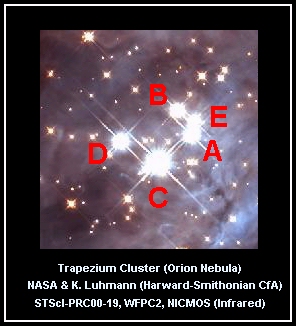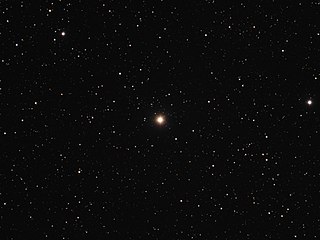
Meissa, designated Lambda Orionis is a star in the constellation of Orion. It is a multiple star approximately 1,300 ly away with a combined apparent magnitude of 3.33. The main components are an O8 giant star and a B-class main sequence star, separated by about 4″. Despite Meissa being more luminous and only slightly further away than Rigel, it appears 3 magnitudes dimmer at visual wavelengths, with much of its radiation emitted in the ultraviolet due to its high temperature.

Merope, designated 23 Tauri, is a star in the constellation of Taurus and a member of the Pleiades star cluster. It is approximately 440 light-years (135 pc) away.
22 Aurigae is a star located 537 light years away from the Sun in the northern constellation Auriga. It is just bright enough to be barely visible to the naked eye under good viewing conditions, appearing as a blue-white hued star with an apparent visual magnitude of 6.45. At the distance of this object, the brightness is diminished by an extinction of 0.57 due to interstellar dust. The star is moving further from the Earth with a heliocentric radial velocity of +10 km/s, and it is a member of the Taurion OB association, located between Orion and Taurus.

Theta1 Orionis C is a member of the Trapezium open cluster that lies within the Orion Nebula. The star C is the most massive of the four bright stars at the heart of the cluster. It is an O class blue main sequence star with a B-type main sequence companion. Its high luminosity and large distance give it an apparent visible magnitude of 5.1.

23 Vulpeculae is a triple star system in the northern constellation of Vulpecula. It is visible to the naked eye as a faint, orange-hued star with an apparent visual magnitude of 4.52 and it is located approximately 327 light years away from the Sun based on parallax. The system is moving further from the Earth with a heliocentric radial velocity of +1.47 km/s.

15 Orionis is a suspected astrometric binary star system in the equatorial constellation of Orion, near the border with Taurus. It is visible to the naked eye as a faint, yellow-white hued star with an apparent visual magnitude of 4.82. The system is approximately 340 light years away from the Sun based on parallax. It is moving further from the Earth with a heliocentric radial velocity of +29 km/s, having come to within 69 light-years some three million years ago.

11 Lacertae is a star in the northern constellation of Lacerta. It is visible to the naked eye as a faint orange-hued star with an apparent visual magnitude of 4.46. It lies at a distance of about 333 light years and has an absolute magnitude -0.54. The object is moving closer to the Earth with a heliocentric radial velocity of −10.9 km/s.

μ Ophiuchi, Latinized as Mu Ophiuchi, is a solitary, blue-white hued star in the equatorial constellation of Ophiuchus. It is visible to the naked as a faint point of light with an apparent visual magnitude of 4.62. This object is located approximately 760 light years away from the Sun based on parallax, but is drifting closer with a radial velocity of −18.5 km/s.

γ Monocerotis, Latinised as Gamma Monocerotis, is a binary star system in the equatorial constellation of Monoceros. Based upon an annual parallax shift of 6.55 mas, it is located roughly 500 light years from the Sun. It can be viewed with the naked eye, having an apparent visual magnitude of 3.96. Gamma Monocerotis is moving away from the Sun with a radial velocity of −5 km/s.

Sigma Persei is an orange K-type giant with an apparent magnitude of +4.36. It is approximately 360 light years from Earth.

Pi6 Orionis (π6 Ori, π6 Orionis) is a solitary star in the eastern part of the constellation Orion. It is visible to the naked eye with an apparent visual magnitude of 4.469. Based upon an annual parallax shift of 3.45 mas, it is around 950 light-years from the Sun. At that distance, the visual magnitude of the star is reduced by an interstellar absorption factor of 0.52.
90 Tauri is a star in the zodiac constellation of Taurus, located 144 light-years away from the Sun. It is visible to the naked eye as a faint, white-hued star with an apparent visual magnitude of 4.27. 90 Tauri is a member of the Hyades cluster and is listed as a double star.

λ Persei, Latinized as Lambda Persei, is a star in the northern constellation of Perseus. It is visible to the naked eye as a faint, white-hued point of light with an apparent visual magnitude of 4.29. This object is located approximately 422 light years from the Sun based on parallax, and is drifting further away with a radial velocity of +6 km/s.

Sigma Ophiuchi, Latinized from σ Ophiuchi, is a single, orange-hued star in the equatorial constellation Ophiuchus. Its apparent visual magnitude is 4.31, which is bright enough to be faintly visible to the naked eye. The annual parallax shift of 3.62 mas as seen from Earth provides a distance estimate of roughly 900 light years. It is moving closer to the Sun with a radial velocity of −28 km/s.

29 Orionis is a single star located around 157 light years away from the Sun in the equatorial constellation of Orion. In Bayer's Uranometria, this star is one of two stars marking the top of Orion's right boot. It has the Bayer designation e Orionis, while 29 Orionis is the Flamsteed designation. This object is visible to the naked eye as a faint, yellow-hued point of light with an apparent visual magnitude of 4.13. It is moving closer to the Earth with a heliocentric radial velocity of -18 km/s.

32 Orionis is a triple star system in the equatorial constellation of Orion. It has the Bayer designation A Orionis, while 32 Orionis is the Flamsteed designation. This system is visible to the naked eye as a faint point of light with a combined apparent visual magnitude of 4.20. It is located approximately 303 light-years away from the Sun based on parallax, and is drifting further away with a radial velocity of +18.6 km/s.

42 Orionis is a class B1V star in the constellation Orion. Its apparent magnitude is 4.59 and it is approximately 900 light years away based on parallax.

49 Orionis is a single star in the equatorial constellation of Orion. It has the Bayer designation d Orionis, while 49 Orionis is the Flamsteed designation. This object is visible to the naked eye as a faint, white-hued star with an apparent visual magnitude of 4.80. It is located 141 light years away from the Sun based on parallax, but is drifting closer with a radial velocity of −5 km/s.

51 Orionis is a single star in the equatorial constellation of Orion. It has the Bayer designation b Orionis, while 51 Orionis is the Flamsteed designation. This object is visible to the naked eye as a faint, orange-hued star with an apparent visual magnitude of 4.90. It is located approximately 299 light-years away from the Sun based on parallax, and is drifting further away with a radial velocity of +88 km/s.

ν Pegasi, Latinized as Nu Pegasi is a single star in the northern constellation of Pegasus. It is an orange-hued star that is faintly visible to the naked eye with an apparent visual magnitude of 4.84. The star is located approximately 261 light years away based on parallax, but is drifting closer with a radial velocity of −19 km/s.









